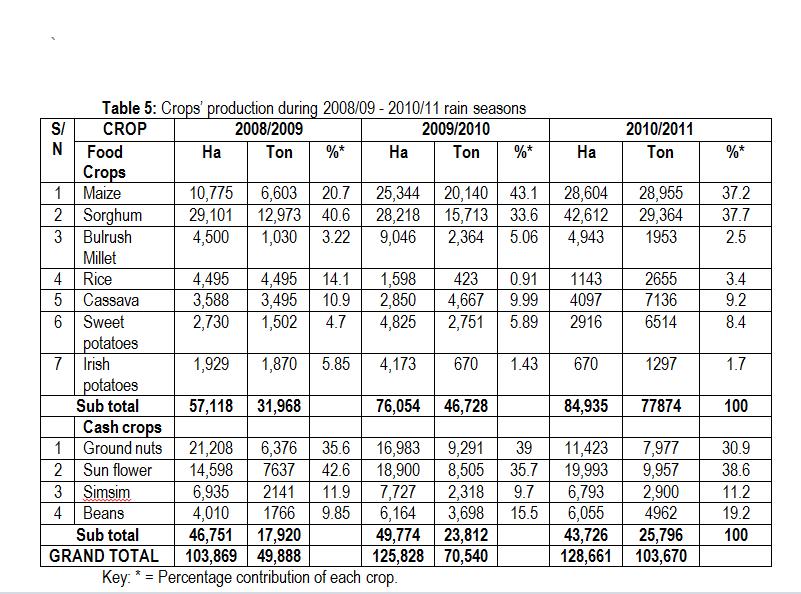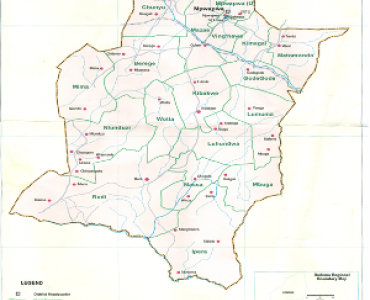Agricultural activities are conducted in all 33 Wards of the Council. Major food crops are maize, millet, beans, paddy and sweet potatoes etc; major cash crops are groundnuts, onions, Sesame and sunflower etc.
The economy of Mpwapwa District relies basically on agriculture, livestock keeping and minor small scale industries in the District. The Agriculture sector still employs more than 80% of the population residing in the Council. Most of the farmers rely on subsistence farming which result in small production hence low income. Crop production is ranked as first vital economic activity and livestock keeping as a second in rural Wards of the District. Apart from arable farming and livestock keeping, natural resource sector is another important sector in which people depend for their livelihoods. However, in most parts of the Council, agriculture is characterized by low productivity due to unfavorable climatic conditions. Council encourages farmers to cultivate drought resistant crops especially bulrush millet, sorghum and cassava.
Agricultural production in the District is dominated by traditional farming practices which typically depend on rain fed, farmers’ local knowledge and experience. Irrigation schemes are not fully developed. The area potential for irrigation in the District is 5991 hectares whereas only 2261 hectares is currently used for irrigation. Green Vegetables including tomatoes, egg plants are grown after rain season. This helps farmers to generate income.
Crops production
During 2008/2009 season, 31,968 tons for food crops were produced. Food requirement for the period of 2009/10 is 70,460 and hence there is a food shortage of 38,492 tones. A total of 39,189 households had food shortage. In 2009/10 season, 46,728 tons of food crops were produced. Food requirement for the period of 2010/2011 were 95,301 tons and therefore there is a shortage of 48,573 tons of food crops.
In 2010/2011 season 77,874 tons of food crops were produced. The food requirement for the period 2011/2012 is.73,661 tons , therefore there is surplus of 4,166 tons.
Generally, farmers produce at subsistence level, this is largely contributed by use of poor farming tools such as hand hoes for tilling land.

Vegetables and Fruits
Area for vegetables and fruits production is about 617 hectors and 6 hectors respectively. During 2010/11 rain season 1,750 fruit trees were planted. Fruits produced are oranges, pawpaw, passion, mangoes and banana. Total average production is 4,825 tones and 38 tones for vegetables and fruits respectively.
Food security
During 2010/2011 season, 77,874 tons for food crops and 25,796 tons for cash crops were produced. Annual food requirement for the period of 2011/12 is 73,661 tones hence there is an overall surplus of .4,166 tons.
Low production was mainly contributed by inadequate, unreliable and poor distribution of rainfall.
Food storage
There are 22,640 storage facilities with the capacity of storing 30,302 tons of food crops (7 godowns - 2,700 tons, 6 improved traditional storage structures (vilindo) - 450 tons and 22,627 traditional storage structures (vihenge) - 27,152 tons).The godowns are in the wards of Mazae, Kibakwe, Lumuma, Mbuga, Luhundwa, Wotta and Rudi, while improved traditional storage structure (vilindo) are in the wards of Mpwapwa 3, Mlunduzi 1, Chunyu 1, and Rudi 1.


Mpwapwa - Dodoma, Tanzania
Anwani: S.L.P 12
Simu: 255 26 2320122/2320
Simu ya Kiganjani: 0684705551
Barua pepe: info@mpwapwadc.go.tz
Copyright © 2021 Mpwapwa District Council . All rights reserved.